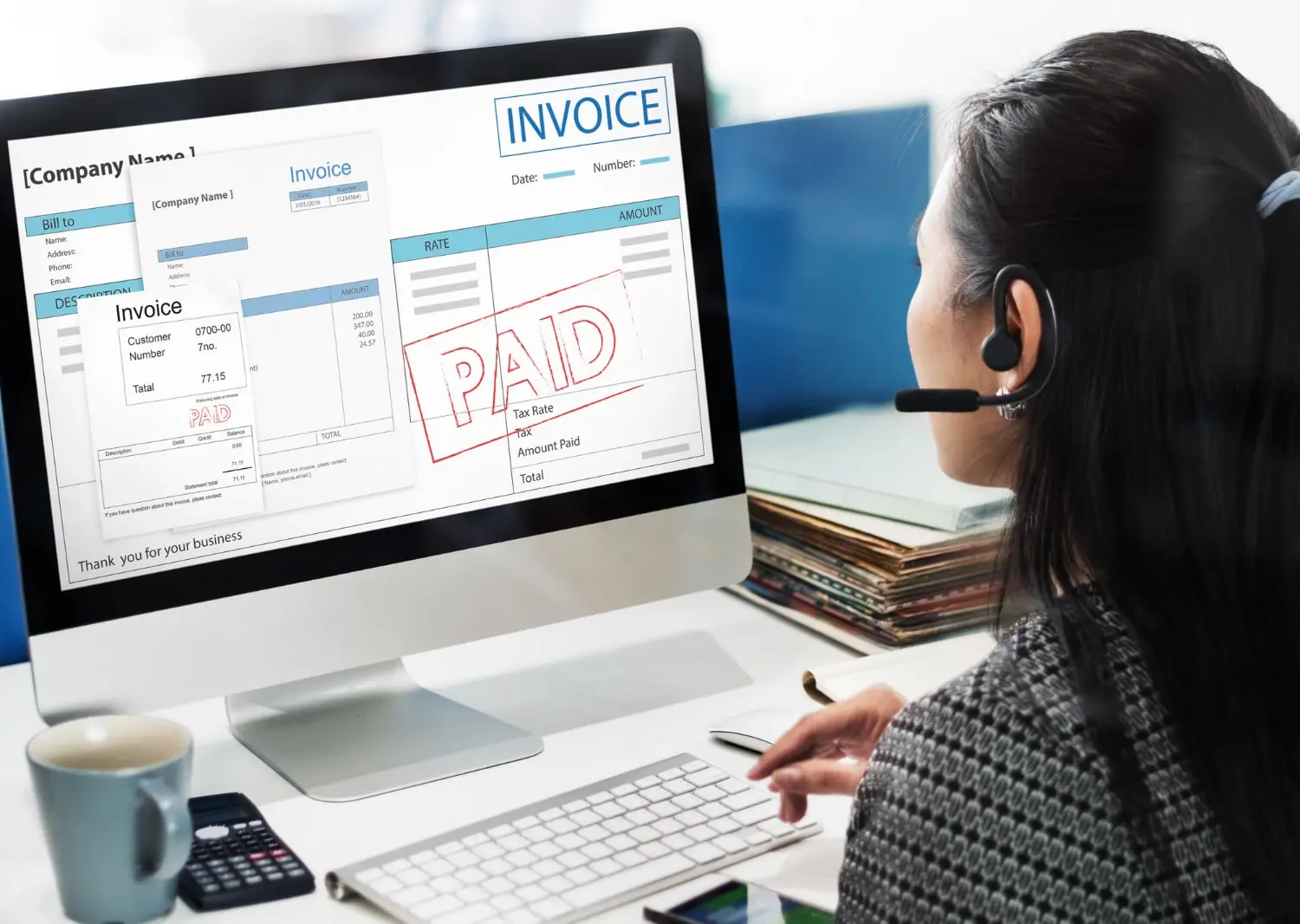What is Accounts Receivable and the Equation for Net Accounts Receivable
Sep 18, 2025

Accounts receivable is a financial metric that represents the amount of money yet to be collected for goods, services, or credit transactions. It illustrates the delicate balance between revenue generation and timely payment.
As a vital component of a company's assets, accounts receivable provides a snapshot of the resources that will flow into the business in the near future.
We will explain the mechanisms, significance, and strategic management strategies surrounding this crucial aspect of financial accounting. From understanding its role in cash flow dynamics to examining the various transactions contributing to its creation, we aim to unravel the complexities of accounts receivable within the context of British business practices.
Why is Accounts Receivable Important?
Accounts receivable, often abbreviated as AR, plays a pivotal role in the fiscal health of businesses, impacting liquidity, operational efficiency, and overall financial stability. It is not merely a financial metric but a strategic element in the holistic framework of financial management.
Cash flow management
Accounts receivable represents funds a company has yet to receive from its customers for goods or services provided on credit. Efficient management ensures a steady and positive cash flow, allowing businesses to meet their financial obligations promptly.
Working capital optimisation
Well-managed accounts receivable contributes to the effective utilisation of working capital. Streamlining collection processes and ensuring timely payments allow businesses to maintain optimal levels of liquidity, invest in growth opportunities, and withstand economic fluctuations.
Customer relationships
Implementing fair and transparent credit terms enhances customer satisfaction and loyalty. Conversely, ineffective receivable management may strain relationships, causing payment delays and disputes.
Financial stability
Monitoring receivables is an indicator of financial health. A consistent or improving AR position reflects strong credit control, while increasing receivable days may signal issues with credit policies, delayed payments, or broader economic challenges.
Strategic decision-making
Insights from AR data guide business decisions. For example, rising receivable days may prompt a company to reconsider credit terms or adopt more assertive collection methods. Timely adjustments based on such insights can safeguard financial stability.
Types of Accounts Receivable
As companies trade, they encounter different types of accounts receivable, each with distinct implications for financial management:
-
Trade receivables – amounts owed by customers for goods or services sold on credit.
-
Non-trade receivables – sums not directly linked to goods or services.
-
Secured and unsecured receivables – depending on whether collateral is attached.
-
Factored receivables – debts sold to third parties at a discount.
-
Matured receivables – invoices past due.
-
Discounted receivables – reduced through early payment incentives.
-
Recurring vs non-recurring receivables – predictable invoices versus exceptional ones.
-
Instalment receivables – scheduled repayments.
-
Contractual and statutory receivables – arising from agreements or legal requirements.
The Accounts Receivable Process
The AR process involves systematic management of funds owed by customers. It starts with issuing invoices, verifying them against purchase orders and delivery receipts, and ensuring accuracy. Approvals, coding, and data entry follow to maintain correct records.
Payments are then scheduled in line with agreed terms such as Net 30. Once approved, they are processed by electronic transfer or cheque, depending on the arrangement.
Accurate record-keeping, reconciliations, and compliance with tax regulations are vital. Businesses also monitor ageing reports to identify late payers and act before debts escalate.
Automation of Accounts Payable
Automation uses software to streamline invoice management and vendor payments. By adopting electronic invoicing, OCR technology, and automated workflows, businesses cut manual work, reduce errors, and speed up approvals.
This transformative approach begins with the adoption of dedicated accounts payable software, carefully selected to align with the unique requirements of a business. A key facet of this automation involves encouraging suppliers to submit electronic invoices, significantly reducing the need for manual data entry and expediting the processing of financial transactions.
Supplier portals and purchase order matching further improve accuracy and collaboration. While automation focuses on efficiency, it also supports healthier financial reporting by reducing delays and discrepancies.
Accounts Receivable Turnover
Accounts receivable turnover is a financial metric that assesses how efficiently a business manages its receivables. It is calculated by dividing the total credit sales by the average accounts receivable for a specific period.
This ratio provides insight into the speed at which a company collects customer payments. A higher turnover ratio indicates a more effective receivables management system, suggesting that the business is rapidly converting its credit sales into cash.
Conversely, a lower turnover ratio may signal potential issues with credit policies, collection processes, or customer payment delays, prompting businesses to reevaluate their strategies for optimal financial performance.
What is Accounts Receivable Financing
Accounts Receivable Financing, also known as invoice financing, is a financial strategy where businesses use their outstanding invoices as collateral to secure funding. In essence, it involves a company borrowing money against the value of its accounts receivable, providing a quick cash injection.
This method helps businesses manage cash flow effectively by accessing funds that are tied up in unpaid invoices. The financing provider typically advances a percentage of the invoice value, and once the customer pays the invoice, the remaining amount, minus fees, is released to the business.
Accounts receivable financing is a versatile option that offers businesses the flexibility to address short-term financial needs without taking on additional debt.
Risks in Accounts Receivable
The management of accounts receivable is not without its challenges, and understanding the associated risks is crucial for businesses navigating financial complexities.
- One primary risk in accounts receivable is credit risk, where businesses face the potential of non-payment or delayed payment by customers, impacting cash flow and liquidity.
- Bad debt risk arises when customers fail to fulfil their payment obligations, leading to financial losses for the business. Monitoring and managing bad debt risk is vital for sustaining financial health.
- Accounts receivable is susceptible to market and economic fluctuations, with changes in customer demand and economic downturns posing threats to timely payments and creditworthiness.
- Risks associated with fraud and mismanagement may occur within the accounts receivable process, requiring robust internal controls to detect and prevent fraudulent activities
- Inaccurate record-keeping poses a risk, affecting financial reporting and decision-making. Regular reconciliation and proper documentation are essential in mitigating this risk.
- Relying heavily on a few key customers poses a risk, as changes in their financial stability or business operations can significantly impact accounts receivable.
- Accounts receivable processes are subject to regulatory standards, and non-compliance can result in legal consequences. Staying abreast of regulations is crucial for mitigating regulatory risks.
- Fluctuations in interest rates can affect the cost of financing accounts receivable, impacting the business's overall profitability and financial health.
- Operational risks encompass errors or inefficiencies in the accounts receivable process, such as late invoicing, inaccurate data entry, or delays in collection efforts, which can hinder overall financial performance.
The Equation for Net Accounts Receivable
This metric provides a realistic snapshot of the money your company expects to collect from its customers after accounting for potential bad debts. There is a straightforward yet vital formula to arrive at this all-important number.
Understanding this equation is key to effective accounts receivable management for business owners seeking financial clarity.
In this article, we will delve into the equation for net accounts receivable, break down its components, and explain its significance in maintaining accurate financial records.
The Equation for Net Accounts Receivable
The equation for net accounts receivable is an essential tool for evaluating the true value of a business's receivables. It begins with the gross accounts receivable - the total amount billed to customers. However, not all billed amounts are expected to be collected due to potential bad debts. This is where the allowance for doubtful accounts comes into effect.
By subtracting this allowance from the gross accounts receivable, we arrive at the net accounts receivable. The formula can be succinctly expressed as:
Net Accounts Receivable = Gross Accounts Receivable - Allowance for Doubtful Accounts
Here is the step-by-step calculation:
- The calculation of net accounts receivable begins with identifying the total gross accounts receivable, which represents the full amount due from customers. You can find it on the balance sheet within a company's annual report or quarterly financial statements.
- Next, determine the allowance for doubtful accounts - an estimate of receivables unlikely to be collected due to customer defaults or other uncertainties. This allowance is typically based on historical data, assessments of customer creditworthiness, and prevailing economic conditions. Methods for estimating the allowance include the percentage of sales method, ageing of accounts receivable method, or a combination of both, depending on the business's specific circumstances.
For example, if a company has £100,000 in gross accounts receivable and estimates a 5% allowance for doubtful accounts, the calculation would be:
Allowance for Doubtful Accounts = £100,000 × 5% = £5,000
- Once the allowance is determined, subtract it from the gross accounts receivable to find the net accounts receivable.
In our example:
Net Accounts Receivable = £100,000 - £5,000 = £95,000
A common mistake is underestimating the allowance for doubtful accounts, which can inflate the net accounts receivable figure. Another pitfall is failing to update the allowance regularly, leading to outdated and inaccurate financial data. Ensuring that all receivables are correctly accounted for in the gross figure is also crucial.
Components of Net Accounts Receivable
Net accounts receivable comprises two main components: gross accounts receivable and the allowance for doubtful accounts.
Gross Accounts Receivable
Gross accounts receivable represents the total amount of money owed to a business by its customers for goods or services delivered but not yet paid for. It is calculated by summing up all outstanding invoices at a given point in time.
For instance, if a company has issued invoices amounting to £100,000 and has received payments totalling £30,000, the gross accounts receivable would be £70,000. This figure does not take into account any potential losses from uncollectible debts. Examples of gross accounts receivable include unpaid invoices for sales, services rendered on credit, and any other outstanding amounts due from customers.
Consider a retail company that sells products on credit. If it has issued invoices worth £50,000 over a month and hasn't received any payments yet, the entire £50,000 is considered its gross accounts receivable.
Another example is a consulting firm that bills clients at the end of a project; if £20,000 is billed and unpaid, this amount is part of the firm's gross accounts receivable. It's important to note that gross accounts receivable provide a snapshot of potential revenue but do not account for non-payment risk.
Allowance for Doubtful Accounts
The allowance for doubtful accounts is a financial estimate used to predict the portion of gross accounts receivable that may not be collected. Its primary purpose is to provide a realistic view of a business's expected cash inflows by accounting for potential bad debts. Estimating this allowance involves analysing historical data on credit losses, customer creditworthiness, and current economic conditions.
For instance, under the percentage of sales method, a company might determine that historically, 2% of its credit sales are uncollectible. If the company has £100,000 in credit sales, it would set aside £2,000 as the allowance for doubtful accounts.
Alternatively, the ageing of accounts receivable method involves categorising receivables by their age and applying different percentages of uncollectibility to each category. For example, 30 days past due receivables might have a 1% uncollectibility rate, while those over 90 days might have a 10% rate.
Consider a business with £50,000 in receivables: £30,000 current, £15,000 30 days past due, and £5,000 90 days past due. Applying respective uncollectibility rates, the allowance might be calculated as follows:
£300 (1% of £30,000) + £1,500 (10% of £15,000) + £500 (10% of £5,000), totalling £2,300.
This allowance is subtracted from the gross accounts receivable to determine the net accounts receivable.
Factors Influencing Net Accounts Receivable
There are several factors that influence net accounts receivable.
- Customer credit policies
If a business adopts lenient credit policies, it may extend credit to a broader range of customers, including those with lower creditworthiness. While this can boost sales, it also increases the risk of uncollectible receivables, raising the allowance for doubtful accounts and subsequently reducing net AR. On the other hand, strict credit policies limit credit to only the most reliable customers, decreasing the risk of bad debts but potentially restricting sales growth.
- Collection practices
Efficient collection practices, such as timely invoicing, regular follow-ups, and clear payment terms, can significantly reduce the amount of doubtful accounts. By actively managing and pursuing outstanding receivables, businesses can improve their cash flow and maintain a higher net AR. Automated systems and dedicated collection teams can further enhance these practices, ensuring that receivables are collected promptly.
- Economic conditions
Customers may face financial difficulties during economic downturns, leading to delays or payment defaults. This increases the allowance for doubtful accounts and decreases net AR. Conversely, businesses and consumers are generally more financially stable in a thriving economy, enhancing the likelihood of timely payments and improving net AR.
Importance of Calculating Net Accounts Receivable
Calculating net accounts receivable is crucial for managing a business's cash flow, as it provides a realistic view of the funds expected to be collected from customers. By understanding net AR, businesses can better evaluate the effectiveness of their credit policies and make adjustments to minimise bad debts.
Accurate net AR calculations also inform strategic business decisions, such as whether to extend credit to certain customers or invest in more aggressive collection practices. Net accounts receivable is an important component of financial reporting and analysis, offering stakeholders a transparent picture of the company's financial health.
It helps assess liquidity, ensuring the business meets its short-term obligations. This figure is also essential for auditors and investors who rely on precise financial data to make informed decisions.
Best Practices for Managing Net Accounts Receivable
Below, we prepared points with several best practices of net accounts receivable management:
- One crucial aspect is maintaining an accurate allowance for doubtful accounts. This can be achieved by regularly reviewing historical data on bad debts, analysing customer payment behaviours, and adjusting the allowance accordingly. Incorporating real-time data and predictive analytics can also enhance the accuracy of these estimates.
- Improving collection rates is another key strategy. Businesses should establish clear payment terms, send timely invoices, and follow up promptly on overdue accounts. Implementing automated reminders and offering multiple payment options can also streamline the collection process and encourage timely payments.
- Accounting software, customer relationship management (CRM) systems, and AR management platforms can automate invoicing, track payments, and provide detailed analytics on receivables. These tools help identify delinquent accounts early and enable more efficient collection process management.
- Regular review and adjustment of the allowance for doubtful accounts are vital to ensure it reflects current economic conditions and customer creditworthiness. This periodic reassessment helps maintain accurate financial statements and prepare for potential cash flow issues.
- Outsourcing accounts receivable management to specialised firms is another option to bring expertise and efficiency to the process. These firms use advanced technologies and proven strategies to maximise collection rates and manage receivables more effectively.
Conclusion
The equation for net accounts receivable is a vital financial tool. By subtracting doubtful accounts from gross receivables, businesses gain a realistic picture of expected cash inflows. This clarity enables smarter credit decisions, tighter collection practices, and stronger financial strategies.
At Payfor, we specialise in helping businesses manage their receivables effectively and recover overdue payments through proven strategies like our 30-Day Chase Campaign. Whether you are dealing with stubborn late payers or want to strengthen your AR processes, our team delivers solutions that protect cash flow and client relationships.
Get in touch with Payfor today and take control of your receivables before small issues turn into big risks.
Disclaimer:
This blog post is intended for informational purposes only and should not be construed as legal advice. The information provided in this post is based on general principles and may not apply to specific legal situations. Laws and regulations vary by jurisdiction and can change over time. Readers are advised to seek professional legal counsel before making any decisions based on the information provided in this blog post. Payfor Ltd is not a law firm and does not provide legal services. The company disclaims any liability for actions taken based on the contents of this blog post.
More Blogs & Insights

How to Chase an Overdue Invoice and How to Implement Effective Reminder Systems

What is the AR Process Workflow and Should you Automate it?

Is It Time to Outsource Accounts Receivable? 5 Signs to Look For and a Cost-Benefit Analysis

Accounts Payable vs Accounts Receivable Key Differences Explained

Comprehensive Guide on Debtor Days Calculation: Formula, Examples and Strategies

How to Handle Business Invoice Disputes With Clients?

What is Accounts Receivable and the Equation for Net Accounts Receivable

The Impact of AR Delays and Strategies for Efficient Accounts Receivable for Spanish Businesses

What is DSO: Learn How to Improve Payment Speeds

How Currency Fluctuations Complicate International Debt Collection

Phoenixing vs Insolvency: Knowing the Difference Could Save Your Business Thousands

Why Small Businesses Are the Biggest Victims of Late Payments in 2025

How Payfor Secured €600,000 for a Ukrainian Tech Firm Against a UK Giant

Spotting Compliance Gaps in Debt Collection Before They Cost Your Business

The Dangers of Partnering with a Debt Collection Agency Without Real Legal Backing

How to Overcome Language and Cultural Hurdles in International Debt Collection

Why Too Much Paperwork Hurts Debt Collection Results

What a Good Recovery Rate Really Looks Like in Global Debt Collection Agencies

How Overcomplicated Debt Collection Processes Delay Your Payment

How Poor Debtor Tracing Damages Your Reputation and Delays Recovery

Why Some Debt Collectors Fail After First Contact and How to Ensure Full Recovery

The Problem with One-Size-Fits-All Debt Collection Strategies and How to Get Better Results

Why You Should Be Concerned If Your Debt Collector Doesn’t Give Regular Updates

The Risks of Misidentifying Debtors in International Debt Recovery and How to Prevent Them

How to Avoid the Costly Mistake of Aggressive Debt Recovery Without Pre-Action Steps

Why Paying Upfront to Other Debt Collectors Often Leads to Bigger Losses

How US Investors Can Recover Money from Failed International Joint Ventures

The Best Way for American Exporters to Collect from Foreign Buyers

How US Businesses Can Recover International Debts Without Expanding Their Legal Team

Recovering Debts After a Business Acquisition or Merger

Understanding the Commercial Debt Collection Struggles Faced by Startups

How Payfor Recovered a $780,000 Hollywood Merchandising Dispute

How an Indian Software Developer Got Paid with Help from Payfor
Payfor was able to collect the outstanding debt by negotiating a resolution between the two companies.

What is Corporate Recovery? How to Recover a Six-Figure Corporate Debt
A Comprehensive Guide to Collecting £100k-£250k Unpaid Invoices from International Businesses

How a Ukrainian Tech Company Secured Payment from a Saudi Debtor
The Ukrainian company had done everything they needed...

Why Most Commercial Debts Remain Unpaid Despite Hiring a Lawyer

How a Portuguese Recruitment Firm Recovered 80% of Its Outstanding Invoices
A recruitment company based in Portugal was owed money from clients in the UK, Portugal and Germany.

$750,000 Production Loan Default Recovered Through Payfor Legal Recovery

How Payfor Recovered a $450,000 Location & Equipment Rental Dispute for a Hollywood Client

The Psychology Behind Legal Recovery and Why It Works

What Legal Recovery Looks Like with Payfor on Your Side

When Debt Collection Fails and Legal Action Becomes the Only Way Forward

Hollywood Insurance Claim Dispute Worth $510,000 Resolved with Payfor’s Help

Securing Payment for Unpaid Post-Production Services Worth $430,000

How We Overcome Frustrating Debt Collections
A Welsh SaaS business was owed money by a London financial services company.

What is Global Debt Collection?
Global debt collection is when a collection agency or company actively tries to collect debts from debtors across international borders.

Commercial Debt Collection Laws in the UK: A Comprehensive Guide
Understanding the legal framework governing commercial debt collection is paramount for both creditors seeking restitution and debtors aiming to protect their rights.

How to Collect Debt From a Business That Repeatedly Refuses to Pay What They Owe
At the start of the Covid Pandemic in the UK early 2020, companies started owing each other money left, right and centre…

How Payfor Helped a Hollywood Studio Recover $612,000 in Sponsorship Fees

How Payfor Helped Resolve a $750,000 Box Office Revenue Sharing Dispute in Hollywood

How Payfor Helped Resolve a High-Value Hollywood IP Infringement Case

How Payfor Resolved a $620,000 Dispute on a Hollywood Distribution Agreement

How Payfor Recovered a $750,000 Talent Payment for a Hollywood Actor

Can You Recover Debt from a Defunct Company? What to Know About Insolvency and Liquidation

What Happens After a Court Judgment? Debt Enforcement Stages Explained

Resolving a $190,000 Licensing Dispute Between Two Record Labels

How Payfor Helped A Record Label Recover Six-Figure Copyright Infringement Damages

How Payfor Helped Recover Over $400,000 in Unpaid Royalties for a New York Record Label

How Payfor Supports Energy Sector Clients in Recovering High-Value Debts

Additional Actions Payfor Pursues Without Further Notice

What Payfor Does If a Debtor Doesn’t Pay Within 5 Days

Legal Recovery for Ad Agencies Left Hanging After Production

Why Delaying Legal Action Can Weaken Your Case

The Dangers of Legal Action for Debtors

Introducing Our Enhanced 30-Day Chase Campaign

How Payfor Recovered $500,000 from an Elusive Debtor in UAE

The $1 Million Debt That Payfor Recovered When Everyone Else Had Given Up

The Three Essential Stages of Effective Debt Collection

Why Debtors Respond to Us When They Ignore Everyone Else

Why Debt Recovery in the Construction Industry Is So Complex—And How to Overcome It

Is Debt Recovery Always Aggressive? Debunking the Myth

£100,000 Recovered from a French Startup by UK-Based Technology Company

The True Cost of Unpaid Invoices for UK Businesses

$120,000 Recovered from a California-Based Tech Giant for an Israeli Software Firm

When Is a Debt Truly Unrecoverable? Knowing When to Write It Off

Top 5 Debtor Excuses We Hear All the Time—And How We Handle Them Professionally

When to Escalate: Signs It’s Time to Hire a Debt Collection Agency

The Psychology of a Debtor: Why They Delay—and How to Get Paid Faster

How Debt Collection Agencies Are Evolving in a Tech-Driven World

Why Businesses Worldwide Trust PayFor with Their Debt Recovery

What Businesses Are the Most Vulnerable to Debt?

7 Skills Every Successful Debt Collector Must Have

How Debt Recovery Agencies Work Within Regulatory Frameworks

What to Expect When Hiring a Debt Collection Agency

A Costly Lesson in Market Vulnerability

How We Recovered a SaaS Subscription Debt Without Litigation

How Persistence Secured a $36K Software Debt Recovery

When a Strong Contract Isn’t Enough: Navigating a Disputed £35K Recruitment Debt

Helping a Global IT Company Recover £37K from a Venture-Backed Biotech Firm

Turning a 600-Day Debt Stalemate into a Strategic Settlement

Leveraging Legal Pressure in a Recruitment Fee Dispute Against a New Jersey Real Estate Development Company

Cloud Infrastructure Billing Dispute between a Global Server Platform and a Ukrainian IT Company

Strategic Recovery in a Cross-Border Financial Dispute between a Ukranian App Developers and a Dublin-based Piracy Protection Platform

Effective Debt Recovery for a London-Based IT Firm

Successful Debt Recovery for a Silicon Valley Software Company

How to Effectively Manage Overdue Payments with Debt Collection Agency

How No Win No Fee Arrangement Works in Debt Collection

Balancing Recovery and Customer Retention in Business Debt Collection

The Evolution of Commercial Debt Collection Practices

Legal Considerations in Commercial Debt Collection Cases

Cereal Entrepreneurs: Mastering the B2B Debt Collection Game

4 Successful B2B Debt Collection Cases

How Commercial Debt Collection Services Help Large Corporations

Top 5 Challenges in B2B Debt Collection and How to Overcome Them

How to Collect Debt From a Business That Repeatedly Refuses to Pay What They Owe?
Coping with a business that repeatedly refuses to pay its debts can significantly impact your cash flow and hinder your company's growth.

Out-of-Court Settlements for Ukrainian Businesses Commercial Debt Collection
As enterprises strive to maintain cash flow and financial stability, resolving commercial debt disputes efficiently becomes crucial for Ukrainian businesses.
How to Track Down a Debtor That’s Gone Missing?
Tracking down a missing debtor can be challenging, but several effective methods can increase your chances of success.

How the Letter Before Action Works in Commercial Debt Collection
One of the most effective tools at a creditor's disposal is the letter before action (LBA). This formal notice is a precursor to legal proceedings and offers a final opportunity for debtors to settle their obligations without court intervention.

Steps to Take Before Engaging a Debt Collection Agency
Hiring a commercial debt collection agency can be immensely helpful for businesses facing challenges in recovering outstanding debts. Professional agencies possess the expertise and resources necessary to efficiently manage business debt recovery.

How to Deal With Reactions to Your Commercial Debt Demand Letter?
Learn how to effectively manage and respond to a range of reactions received following the issuance of your commercial debt demand letter.
Business Debt Collection Best Practices for Israeli Tech Businesses
As the Israeli tech industry thrives on continuous development and investment, managing outstanding debts efficiently becomes crucial to ensure that financial stability is not compromised. Implementing best practices for debt collection tailored to each firm's unique needs can significantly mitigate these risks.

What is Commercial Litigation?
Defined as the legal process of resolving business-related conflicts through the court system, commercial litigation covers many issues - breach of contract, business torts, shareholder disputes, and intellectual property disagreements.

Commercial Debt Collection for Small and Medium Enterprises (SMEs) in Ukraine
Small and medium enterprises (SMEs) play a crucial role in Ukraine’s economic growth and job creation. However, many SMEs grapple with cash flow challenges due to market fluctuations.

The Role of Professional Debt Collection Agencies for Ukrainian Businesses
In Ukraine's dynamic business scene, managing outstanding business debts is challenging and can strain resources.

Best Strategies for Commercial Debt Management: Advice From an Expert
In today's competitive landscape, businesses must navigate complex financial relationships while balancing cash flow and creditor obligations.

How to Recognise Early Warning Signs of Business Debtors?
Recognising the early signs of a potential debtor is crucial for maintaining a business's financial health. Many companies encounter clients who, despite initial promises, fail to uphold their payment obligations, which can significantly impact cash flow and operational stability.

How Can You Recover a Debt in the US When You Are in Portugal?
Distance, legal disparities, and practical hurdles create complexities for Portuguese businesses seeking to recover commercial debts from businesses in the United States.

Commercial Debt Collection Laws for Ukrainian Businesses
Ukrainian businesses frequently grapple with managing financial obligations and recovering debts. The legal framework for commercial debt collection is vital for maintaining economic stability and fair market practices.

What to Do When a Client Cancels a Business Agreement?
When a client cancels a deal, it can significantly disrupt your business operations, impacting both your financial stability and strategic planning.

International Commercial Debt Collection Laws Explained
International debt collection involves pursuing debts from debtors in different countries - a challenge heightened by diverse legal systems, cultures, and language barriers.

What Happens If You Lose a Commercial Debt Collection Lawsuit?
Unpaid debts can pose significant challenges to business financial stability. When traditional methods fail to resolve these outstanding dues, companies may take legal action, such as a commercial debt collection lawsuit.

When to Use a Commercial Debt Collector?
Businesses often face challenges in recovering payments from clients or customers when managing outstanding debts.

How Long Can You Legally Be Chased for a Commercial Debt in the UK?
In the UK, the statute of limitations for pursuing a commercial debt is typically six years, starting from the last acknowledgment or payment date.

What is Commercial Debt Factoring in Business?
Companies often seek innovative solutions for cash flow management and financial challenges, such as commercial debt factoring, where accounts receivable are sold to a third-party factor at a discount.

How to Recover a Commercial Debt in the US When You Are in Israel?
If you are an Israeli business seeking to recover a commercial debt owed to you in the United States, it's essential to understand the intricacies and procedures involved in such a pursuit.

Legal Procedure for Commercial Debt Recovery
Commercial debt recovery can be a complex and challenging process for businesses. From unpaid invoices to overdue payments, encountering debtors unwilling to settle outstanding dues is a common predicament.

How Do Businesses Benefit From Offshore Jurisdictions?
Offshore jurisdictions like Switzerland and the Cayman Islands are a prevalent strategy for companies engaged in commercial debt collection or aiming to enhance their financial and tax planning initiatives.

How Do You Write a Demand Letter for Commercial Debt?
Unpaid business debts can be challenging for commerce businesses. When traditional debt collection methods fail, turning to legal recourse becomes necessary.

How to Avoid Late Payments in B2B Transactions?
Late payments pose a significant challenge for businesses, impacting cash flow, profitability, and overall financial stability.

Commercial Debt Statistics: Facts and Numbers
Commercial debt plays a vital role in business finances, acting as both a driver for growth and a potential indicator of a company's financial stability.

Why Payfor Is Different From Other B2B Collection Agencies?
Unlike other agencies, Payfor prides itself on its unique approach to commercial debt recovery, blending industry expertise with a commitment to client satisfaction.

How to Calculate Business Debt: A Comprehensive Guide
Understanding and accurately calculating business debt is essential for maintaining financial stability and making informed decisions.

How to Recover a Debt in the US When You Are in Egypt?
Given the geographical and legal barriers, recovering a debt in the United States while residing in Egypt can present a formidable challenge.

What are Commercial Debt Collection Challenges for Startups?
Startups often encounter unique hurdles when it comes to recovering owed funds. From establishing effective credit policies to navigating legal complexities, startups must navigate myriad obstacles to ensure timely payments and maintain financial stability.

Negotiation Tactics in Debt Recovery: The Psychology of Persuasion.
Commercial debt recovery is an essential, yet intricate, facet of business operations that requires an amalgamation of skills—from legal understanding to business acumen.

How to Recover Debt in the US When You're in Ukraine?
Navigating the complexities of debt recovery across international borders presents unique challenges for businesses, particularly when seeking to recover debts owed in the United States while operating from Ukraine.

Is Legal Recovery the Answer When Your Business is Owed Money Across Borders?
When your business faces the challenge of recovering owed money from companies operating across international borders, legal recovery emerges as a strategic imperative.

How Do Commercial Debt Collection Recovery Campaigns Work?
Commercial debt collection recovery campaigns are intricate processes designed to retrieve outstanding debts owed by businesses to creditors.

Why Jurisdiction Is the Most Critical Factor in Commercial Debt Collection?
When it comes to commercial debt collection, one question often trumps all others: "What is the key most important factor when chasing a debt?"

What is the Difference Between Arbitration and Issuing Legal Proceedings/Litigation?
The choice between arbitration and litigation is a pivotal decision that can shape the course of dispute resolution.

What is Amicable Recovery?
Amicable Recovery is a consensual and cooperative debt collection method that aims to settle outstanding payments without resorting to judicial measures. This process often commences with a courteous reminder, followed by mutually beneficial negotiations, in an effort to secure payment.

What is Jurisdiction in Global B2B Debt Collection?
Jurisdiction determines the legal authority and framework within which commercial debt collection efforts can be pursued across international borders.

How to Determine if a Debtor is Solvent Enough to Repay Debt: An Expert Guide
In the intricate world of commercial debt collection, one of the most challenging yet imperative tasks is assessing the solvency of a debtor.

Small Business Debt Collection: A 7 Point Guide
This guide covers seven key points, ranging from understanding legal frameworks to negotiating payment plans. It equips small business owners with the knowledge and tools necessary to successfully pursue outstanding debts.

What is Commercial Debt Collection?
Commercial debt collection is when a third-party agency recovers unpaid debts owed by one company to another. The recovery agency contacts the company owing the debt requiring it to pay the debt.

What Are Commercial Debt Collection Challenges for US Companies?
Commercial debt collection presents myriad challenges for US businesses, including complex jurisdictions and contractual elements.

How Much Debt Should a Business Have?
Striking the right balance between business debt and equity is paramount for maintaining financial health and sustaining growth.

Commercial Debt Collection Challenges and Solutions for Ukrainian Businesses
In today's economic climate, Ukrainian companies encounter many obstacles when recovering commercial debts.

How is Bad Debt Defined in Business: A Short Explanation
The term "bad debt" holds significant importance for businesses and can often signal trouble for enterprises of varying sizes.

What is a Creditor in Business?
A creditor is a party that has provided goods, services, or monetary resources to a business on credit, expecting repayment within an agreed timeframe.

What is a Commercial Debt for Business?
Commercial debt is the amount of money one business entity owes to another for goods or services provided on credit terms.

What Should Businesses Expect From a Modern-Day Debt Recovery Agency?
Modern debt recovery firms are redefining industry standards by offering strategic financial solutions alongside traditional collection efforts.

How to Safeguard Your Business: Expert Tips for Choosing Reliable B2B Partners and Clients
In today's rapidly evolving business landscape, establishing robust B2B partnerships and securing dependable clients are pivotal to achieving growth.

What Are Commercial Debt Collection Challenges and Solutions for UK Companies?
Navigating the complexities of commercial debt recovery in the UK presents many challenges that demand a strategic understanding and adept handling.

A Comprehensive Guide to Commercial Debt Collection for AI Companies
As AI businesses often market their technology globally, cross-border trade is a notable challenge they face.

How Does Commercial Debt Collection Work for Recruitment Companies?
As recruitment agencies strive to connect employers with suitable candidates, the issue of outstanding payments can become a common challenge for them.

What are Debt Collection Agencies: Their Role in Financial Recovery
The debt collector is mainly an agency creditors hire to recover money owed by businesses that have failed to make timely payments on their debts.

Commercial Debt Collection Issues for IT and Software Development Companies
The billing models, project timelines, and evolving client requirements create an environment where debt recovery becomes a complex and nuanced process for IT and Software development companies.

Business Debt Collection Etiquette: How to Preserve B2B Relationships
In the ever-evolving landscape of business, maintaining positive relationships with other companies is crucial for long-term success. However, as businesses engage in commercial transactions, they may encounter instances where debtors are not forthcoming, acting in bad faith, or having a hidden agenda.

What is a Debtor in Business: Essential Guide
Commercial debtors, in essence, refer to entities that owe money to a business for goods or services provided. This financial relationship forms a critical component of the broader commercial ecosystem, shaping a business's cash flow dynamics and overall financial health.

What to Do if a Company Owes You Money: Resolving Unsettled Debts
In a business relationship, there might be situations where a company owes you money, and the path to resolution may not always be clear. When faced with this challenge, it's crucial to approach the situation with a level head and a strategic plan.








